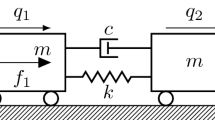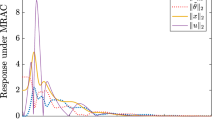Abstract
The aim of this paper is to develop an efficient and robust parallel numerical continuation method for periodic solutions of local nonlinear systems. In this method, a component mode synthesis method is first employed to reduce the nonlinear system with local nonlinearity; the parallel principle is implemented in the correction part of the classic pseudo-arc length continuation, and the step control strategy is dependent on historical and current information from multiple cores. In addition, a numerical continuation (NC) jumping phenomenon may occur alongside the periodic solution tracking process; a geometrical indicator algorithm based on the frequency–amplitude curve is utilized to prevent NC jumping and enhance the robustness of the tracking behavior. By applying the methodology to a nonlinear energy sink and a rod-fastened rolling bearing rotor system, it is shown that numerical continuation can be employed to calculate periodic solutions efficiently and robustly.

















Similar content being viewed by others

References
Friswell, M.I., Penny, J.E.T., Garvey, S.D.: Using linear model reduction to investigate the dynamics of structures with local non-linearities. Mech. Syst. Signal Process. 9, 317–328 (1995). https://doi.org/10.1006/mssp.1995.0026
Fey, R.H.B., van Campen, D.H., de Kraker, A.: Long term structural dynamics of mechanical systems with local nonlinearites. J. Vib. Acoust. 118, 147–153 (1996). https://doi.org/10.1115/1.2889642
Zheng, T.S., Hasebe, N.: An efficient analysis of high-order dynamical system with local nonlinearity. J. Vib. Acoust. 121, 408–416 (1999). https://doi.org/10.1115/1.2893995
Wang, S., Wang, Y., Zi, Y.Y., He, Z.J.: A 3D finite element-based model order reduction method for parametric resonance and whirling analysis of anisotropic rotor-bearing systems. J. Sound Vib. 359, 116–135 (2015). https://doi.org/10.1016/j.jsv.2015.08.027
Lu, K., Jin, Y.L., Chen, Y.S., Yang, Y.F., et al.: Review for order reduction based on proper orthogonal decomposition and outlooks of applications in mechanical systems. Mech. Syst. Signal Process. 123, 264–297 (2019). https://doi.org/10.1016/j.ymssp.2019.01.018
Kim, S., Palazzolo, A.: Shooting/continuation based bifurcation analysis of large order nonlinear rotordynamic systems. In: MATEC Web of Conferences, Lisbon (2018). https://doi.org/10.1051/matecconf/201821118003
Dobbs, J.R., Hencey, B.M.: Structured building model reduction toward parallel simulation. In: 13th Conference of International Building Performance Simulation Association, Chambéry (2013)
Sundararajan, P., Noah, S.T.: Dynamics of forced nonlinear systems using shooting/arc length continuation method-application to rotor systems. J. Vib. Acoust. 119, 9–20 (1997). https://doi.org/10.1115/1.2889694
Doedel, E.J., Oldeman, B.E.: AUTO-07P: Continuation and Bifurcation Software for Ordinary differential Equations. Concordia University, Montreal (2012)
Dhooge, A., Govaerts, W., Kuznetsov, Y.A.: Matcont: a matlab package for numerical bifurcation analysis of odes. ACM Trans. Math. Softw. 29, 141–164 (2003). https://doi.org/10.1145/779359.779362
Salles, L., Staples, B., Hoffmann, N., Schwingshackl, C.: Continuation techniques for analysis of whole aeroengine dynamics with imperfect bifurcations and isolated solutions. Nonlinear Dyn. 86, 1897–1911 (2016). https://doi.org/10.1007/s11071-016-3003-y
Xie, L., Baguet, S., Prabel, B., Dufour, R.: Bifurcation tracking by harmonic balance method for performance tuning of nonlinear dynamical systems. Mech. Syst. Signal Process. 88, 445–461 (2017). https://doi.org/10.1016/j.ymssp.2016.09.037
Chávez, J.P., Wiercigroch, M.: Bifurcation analysis of periodic orbits of a non-smooth Jeffcott rotor model. Commun. Nonlinear Sci. Numer. Simul. 18, 2571–2580 (2013). https://doi.org/10.1016/j.cnsns.2012.12.007
Adiletta, G.: An insight into the dynamics of a rigid rotor on two-lobe wave squeeze film damper. Tribol. Int. 116, 69–83 (2017). https://doi.org/10.1016/j.triboint.2017.06.029
Sghir, R., Chouchane, M.: Nonlinear stability analysis of a flexible rotor-bearing system by numerical continuation. J. Vib. Control 22, 3079–3089 (2016). https://doi.org/10.1177/1077546314558133
Boyaci, A.: Numerical continuation applied to nonlinear rotor dynamics. Procedia IUTAM 19, 255–265 (2016). https://doi.org/10.1016/j.piutam.2016.03.032
Seydel, R.: Practical Bifurcation and Stability analysis From Equilibrium to Chaos. Springer, New York (2010)
Allgower, E.L., Georg, K.: Introduction to Numerical Continuation Methods. Springer, Berlin (2003)
Sundararajan, P., Noah, S.T.: An algorithm for response and stability of large order non-linear systems- application to rotor systems. J. Sound Vib. 214, 695–723 (1998). https://doi.org/10.1006/jsvi.1998.1614
Castillo, Z.: A new algorithm for continuation and bifurcation analysis of large scale free surface flows. Ph.D. Thesis, Rice University (2004). https://pdfs.semanticscholar.org/b8f7/3c13d50a210f6c3939cfad83eefb3e101b86.pdf. Accessed 4 Sept 2018
Léger, S., Deteix, J., Fortin, A.: A Moore-Penrose continuation method based on a Schur complement approach for nonlinear finite element bifurcation problems. Comput. Struct. 152, 173–184 (2015). https://doi.org/10.1016/j.compstruc.2015.02.003
Cherfils, L.: A parallel and adaptive continuation method for semilinear bifurcation problems. Comput. Methods Appl. Mech. Eng. 163, 247–259 (1998). https://doi.org/10.1016/S0045-7825(98)00017-6
Kim, S., Palazzolo, A.B.: Bifurcation analysis of a rotor supported by five-pad tilting pad journal bearings using numerical continuation. ASME J. Tribol. (2018). https://doi.org/10.1115/1.4037699
Aruliah, D.A., Veen, L.V.: Algorithm 956: PAMPAC, a parallel adaptive method for pseudo-arclength continuation. ACM Trans. Math. Softw. (2016). https://doi.org/10.1145/2714570
Stoykov, S., Margenov, S.: Scalable parallel implementation of shooting method for large-scale dynamical systems: application to bridge components. J. Comput. Appl. Math. 293, 223–231 (2016). https://doi.org/10.1016/j.cam.2015.04.015
Stoykov, S., Margenov, S.: Numerical methods and parallel algorithms for computation of periodic responses of plates. J. Comput. Appl. Math. 310, 200–212 (2017). https://doi.org/10.1016/j.cam.2016.06.040
Choi, S.H., Harney, D.A., Book, N.L.: A robust path tracking algorithm for homotopy continuation. Comput. Chem. Eng. 20, 647–655 (1996). https://doi.org/10.1016/0098-1354(95)00199-9
Yamamura, K. Adachi, K.: A modified predictor-corrector method for tracing solution curves. In: Proc. IEEE Asia pacific conference on circuits and systems, pp. 372–375. Jeju (2016)
Yu, Y., Yu, B., Dong, B.: Robust continuation methods for tracing solution curves of parameterized systems. Numer. Algoritms 65, 825–841 (2014). https://doi.org/10.1007/s11075-013-9716-9
Liu, H., Chen, L.: Nonlinear dynamic analysis of a flexible rod fastening rotor bearing system. In: Proceedings of the ASME TURBO EXPO 2010, pp. 389–398. Glasgow (2010)
Detroux, T., Renson, L., Masset, L., Kerschen, G.: The harmonic balance method for bifurcation analysis of large-scale nonlinear mechanical systems. Comput. Methods Appl. Mech. Eng. 296, 18–38 (2015). https://doi.org/10.1016/j.cma.2015.07.017
Keller, H.B: Numerical methods in Bifurcation problems. Tata Institute of Fundamental Research, Bombay (1987)
Didier, J., Sinou, J.J., Faverjon, B.: Nonlinear vibrations of a mechanical system with non-regular nonlinearities and uncertainties. Nonlinear Sci. Numer. Simul. 18, 3250–3270 (2013). https://doi.org/10.1016/j.cnsns.2013.03.005
Yi, J., Liu, H., Liu, Y.: Global nonlinear dynamic characteristics of rod-fastening rotor supported by ball bearings. Proc. Inst. Mech. Eng. Part K J. Multi-Body Dyn. 229, 208–222 (2015). https://doi.org/10.1177/1464419314557846
Acknowledgements
The authors gratefully acknowledge the support of the National Natural Science Foundation of China (Grant Nos. 51605380, 51475357).
Author information
Authors and Affiliations
Corresponding author
Ethics declarations
Conflict of interest
The authors declare that they have no conflict of interest.
Additional information
Publisher's Note
Springer Nature remains neutral with regard to jurisdictional claims in published maps and institutional affiliations.
Appendix
Appendix
1.1 Rod model
Fastened rod mass is very small compared with the whole rotor system so that it could be regarded as linear spring without mass effect. Four parts shown in Fig. 18a are assembled through twelve circumferentially distributed rods. The dynamical character of rod-fastened rotor system will be similar with the intact rotor, provided the rod preloads are large enough [34]. A disk shaft model with twelve circumferentially distributed springs is utilized to approximate rod-fastened rotor system in Fig. 18b.
Operational load of ith rod Fi is written as follows
where \( F_{0}^{i} \) is the initial preload of ith rod and \( L_{0}^{i} \) is the initial preloaded length of ith rod; E represents elasticity modulus of rod material and A is cross-sectional area of rod; ∆Li is the elongation of ith rod.
Coordinate system of rod model shown in Fig. 19 is established; axial and torsional vibrations are not considered in this paper. Disk stiffness is usually so large that it could be regarded as rigid body, circumferentially distributed rod load \( {\mathbf{F}}_{1}^{i} \) of disk 1 could be replaced by equivalent force \( {\hat{\mathbf{F}}}_{1}^{i} \) and moment \( {\hat{\mathbf{M}}}_{1}^{i} \) acted on circle center of disk 1; equivalent force \( {\hat{\mathbf{F}}}_{4}^{i} \) and moment \( {\hat{\mathbf{M}}}_{4}^{i} \) are chosen to replace circumferentially distributed rod load \( {\mathbf{F}}_{4}^{i} \) of disk 4.
\( F_{x1}^{i} \), \( F_{y1}^{i} \) are x, y coordinate components of \( {\mathbf{F}}_{1}^{i} \) in inertial coordinate system OXYZ. \( {\hat{\mathbf{F}}}_{1}^{i} \) only consists of x, y coordinate components, and \( {\hat{\mathbf{M}}}_{1}^{i} \) consists of φ, ψ coordinate components.
Similarly, \( {\hat{\mathbf{F}}}_{4}^{i} \) and \( {\hat{\mathbf{M}}}_{4}^{i} \) could be expressed as follows:
1.2 Rolling bearing model
where θj is the position angle of jth ball shown in Fig. 20; Nb is the ball number; ωc, ωi and ωo represent the rotational speeds of cage, inner ring and outer ring, respectively; Ri and Ro are radii of inner and outer race, respectively.
The elastic deformation between jth ball and races is written as
x and y represent displacements of inner race center in the horizontal and vertical directions, respectively; γ is radial clearance between balls and races.
kj is the normal contact stiffness between jth ball and races. Qj is contact force between jth ball and races; Fb is bearing force vector acted on the shaft, which contains x direction component fbx and y direction component fby; cb is damping coefficient.
Rights and permissions
About this article
Cite this article
Wang, Q., Liu, Y., Liu, H. et al. Parallel numerical continuation of periodic responses of local nonlinear systems. Nonlinear Dyn 100, 2005–2026 (2020). https://doi.org/10.1007/s11071-020-05619-1
Received:
Accepted:
Published:
Issue Date:
DOI: https://doi.org/10.1007/s11071-020-05619-1






